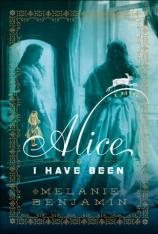Alice I Have Been
Review
Alice I Have Been
Who is the “real” Alice in Wonderland? Who is the “real” Peter Pan? Did such people actually exist? As it turns out, yes. And this --- part historical novel based on pieced-together facts, part richly imagined fiction --- is the “real” Alice’s story.
But first, a bit of fact before getting to the fiction. For those of you who may not know, Lewis Carroll’s real name was Charles Lutwidge Dodgson. He was a mathematics professor at Christ Church, Oxford, and closely acquainted with the Dean of Colleges’ family, the Liddells. During the late 1860s, the reclusive, stuttering Dodgson spent much of his time with the Liddells --- especially their three eldest daughters (Ina, Alice and Edith) --- accompanying them on walks, taking their portraits and telling them fantastical stories. His most famous story, of course, is the whimsical yarn he spun about a girl who followed a White Rabbit down a rabbit hole --- the one he wrote, as per the gossip mill, for Alice Liddell.
Whether or not this last bit is true has yet to be verified. But Melanie Benjamin begins ALICE I HAVE BEEN not where Carroll supposedly left off, but by simply imagining a much-changed and often haggard Alice who grows up and defiantly turns her back on the blond-haired, dimpled storybook heroine who shares her name in favor of forging a life unimpeded by secret glances once exchanged between a prepubescent girl and a particularly infatuated man 20 years her senior. Unimpeded, but for the haunting memories of that time that remain.
So, while Benjamin’s novel should never be taken as fact, it’s certainly easy to get swept away in the story she tells. The engrossing saga is broken up into three segments: Alice’s privileged childhood at the Deanery, including her fabled scandalous “relationship” with Charles Dodgson when she’s barely 11; her life as a young woman, encompassing a gorgeously-rendered but sadly ill-fated love affair with Prince Leopold, a distant heir to the British throne; and her later years, which consist mostly of mourning the loss of various loved ones: her husband, two out of three sons during World War I, Ina, and the long-since estranged Dodgson.
Of the three, the first is the breeziest to read, albeit uncomfortable, at times, to swallow. Benjamin fills these pages with vivid descriptions of the children’s carefully pressed white frocks, the mostly good-natured rivalry between the sisters, the “flitting” and “fussing” of their socialite mother, and the stifling Victorian mores of the period. The supposedly innocent yet slightly lurid moments when Dodgson photographs the girls --- especially the time he snaps a barefooted Alice in a tattered gypsy dress --- hint at Dodgson’s creepy, possibly pedophilic tendencies (although, in truth, the real Dodgson photographed other subjects including men, though that’s not mentioned here).
The chapters that cover Alice’s romance with Prince Leopold are just as captivating as those exploring her childhood (if, perhaps, more so due to more potential for bodice ripping). It’s easy to get carried away envisioning the balls attended, the hushed talks of potential marriages and engagements, and the plans for the future.
But the most revealing (though unfortunately disappointing) section deals with Alice’s later years. Delivered at a rushed pace compared to the luxuriously languid feel of the novel’s first half, many readers will be left wanting more. Here, we watch her three sons ship off to battle and witness Alice’s underappreciated husband, Regi, wither away when they leave, but we don’t know him well enough as a character to really care. Other family tragedies pass with scarcely a mention. Even the squirrelly Dodgson’s death is underwritten, which seems odd for a character with so central a presence. Perhaps this brief treatment is necessary, as it reflects Alice’s blocked emotional state. But it leaves us feeling somewhat robbed, especially after such a captivating and intricately crafted setup. Take this quote toward the end:
“Through the looking glass, indeed. For there really was no logic to my life; I had traveled and searched and questioned and loved and tried, so very hard, yet still I ended up in this place with no answers, no solutions. There was no Wonderland; there had never been a Wonderland. There was only me, looking at myself in a mottled glass, unable to recognize the child I had been, the woman I had become, alone now with nothing to my name but a crumbling old house”
While accurate, it almost comes across as resignation instead of a longing for things to have been different.
In the book’s final pages, when we finally learn the reason (or purported reason) why Dodgson broke from the Liddells, and why Alice distanced herself from her Wonderland fame, it is a testament to Benjamin’s talent for dropping clues and shaping a good mystery that we are shocked, although perhaps not surprised. Most compassionate readers will probably grieve not only for Alice and the life she was denied, but also for the tortured and lonely man who was responsible.
ALICE'S ADVENTURES IN WONDERLAND continues to capture the hearts and imaginations of children --- and with the Tim Burton movie releasing in March, there will be even more interest in this story. But just as Carroll’s tale requires a certain suspension of disbelief, so, too, does ALICE I HAVE BEEN. While the story of a girl’s reputation squandered is certainly bleaker than one involving Cheshire cats and smoking caterpillars, Carroll and Benjamin have at least one thing in common: as writers, they understand that the magic of a story resides in its telling.
Reviewed by Alexis Burling on January 5, 2011
Alice I Have Been
- Publication Date: January 12, 2010
- Genres: Fiction, Historical Fiction
- Hardcover: 368 pages
- Publisher: Delacorte Press
- ISBN-10: 0385344139
- ISBN-13: 9780385344135




